
Vergina is a small town in Northern Greece, part of Veria municipality in Imathia, Central Macedonia. Vergina was established in 1922 in the aftermath of the population exchanges after the Treaty of Lausanne and was a separate municipality until 2011, when it was merged with Veroia under the Kallikratis Plan.
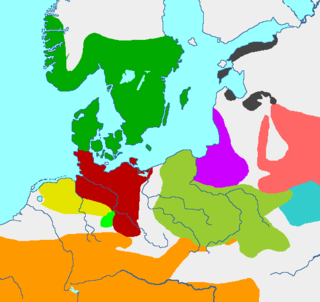
The Pomeranian culture, also Pomeranian or Pomerelian Face Urn culture was an Iron Age culture with origins in parts of the area south of the Baltic Sea, from the 7th century BC to the 3rd century BC, which eventually covered most of today's Poland.
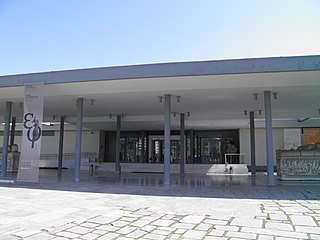
The Archaeological Museum of Thessaloniki is a museum in Thessaloniki, Central Macedonia, Greece. It holds and interprets artifacts from the Prehistoric, Archaic, Classical, Hellenistic and Roman periods, mostly from the city of Thessaloniki but also from the region of Macedonia in general.
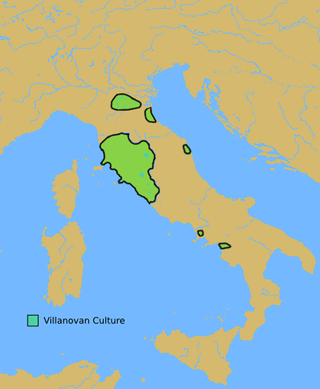
The Villanovan culture, regarded as the earliest phase of the Etruscan civilization, was the earliest Iron Age culture of Italy. It directly followed the Bronze Age Proto-Villanovan culture which branched off from the Urnfield culture of Central Europe. The name derives from the locality of Villanova, a fraction of the municipality of Castenaso in the Metropolitan City of Bologna where, between 1853 and 1855, Giovanni Gozzadini found the remains of a necropolis, bringing to light 193 tombs, of which there were 179 cremations and 14 inhumations.

Assos was an ancient Greek city near today's Behramkale or Behram for short, which most people still call by its ancient name of Assos. It is located on the Aegean coast in the Ayvacık district of Çanakkale province, Turkey. It is on the southern side of Biga Peninsula. Assos sits on the coast of the Adramyttian Gulf and used to offer the only good harbour along the 80 kilometres (50 mi) of coast which made it very important for shipping in the Troad.
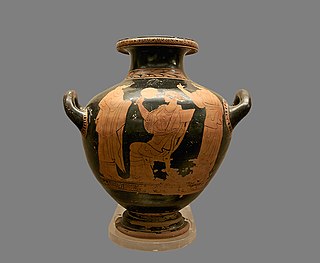
The hydria is a form of Greek pottery from between the late Geometric period and the Hellenistic period. The etymology of the word hydria was first noted when it was stamped on a hydria itself, its direct translation meaning 'jug'.
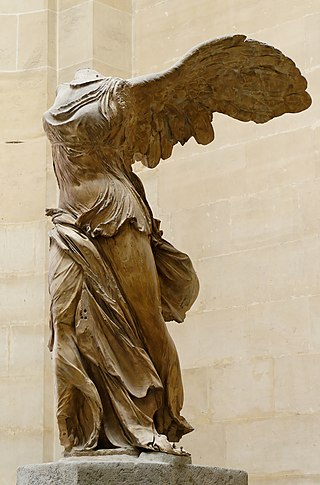
Hellenistic art is the art of the Hellenistic period generally taken to begin with the death of Alexander the Great in 323 BC and end with the conquest of the Greek world by the Romans, a process well underway by 146 BC, when the Greek mainland was taken, and essentially ending in 30 BC with the conquest of Ptolemaic Egypt following the Battle of Actium. A number of the best-known works of Greek sculpture belong to this period, including Laocoön and His Sons, Venus de Milo, and the Winged Victory of Samothrace. It follows the period of Classical Greek art, while the succeeding Greco-Roman art was very largely a continuation of Hellenistic trends.

Etruscan art was produced by the Etruscan civilization in central Italy between the 10th and 1st centuries BC. From around 750 BC it was heavily influenced by Greek art, which was imported by the Etruscans, but always retained distinct characteristics. Particularly strong in this tradition were figurative sculpture in terracotta, wall-painting and metalworking especially in bronze. Jewellery and engraved gems of high quality were produced.

The Archaeological Museum of Dion is a museum in Dion in the Pieria regional unit of Central Macedonia, Greece.

The Archaeological Museum of Florina is a museum in Florina in West Macedonia, Greece.
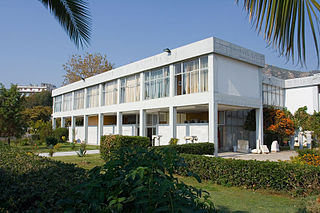
The Archaeological Museum of Kavala is a museum in Kavala, Eastern Macedonia, Greece, located towards the western end of the Ethnikis Antistasis road in Kavala.
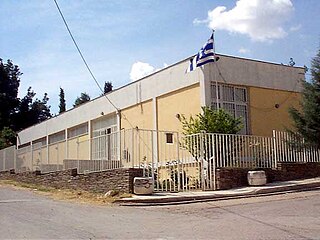
The Kilkis Archaeological Museum is located in the city of Kilkis in Central Macedonia, Greece. It opened in 1972, its purpose being to collect finds handed in by private individuals and unearthed during excavations in the Kilkis area. The exhibits are arranged in the rooms in chronological order, they date from the Neolithic to the Roman period, and they come from excavations in the settlement of Kolchida, the cemetery at Palaio Gynaikokastro, the archaeological site at Filyria, and other parts of the Kilkis Prefecture.

The Isis Tomb is a richly endowed Etruscan chamber tomb that was found at the Polledrara Cemetery, Vulci, Lazio, Italy, in the early nineteenth century. Many artefacts were discovered in the Isis Tomb when it was originally excavated but, as was custom at the time, only objects of high monetary value were kept. Over 60 of these objects are now held by the British Museum, with others scattered across a range of museums around the world.

Tarsus Museum is an archaeology and ethnography museum in Tarsus, Mersin Province, in southern Turkey.

Ancient Greek art stands out among that of other ancient cultures for its development of naturalistic but idealized depictions of the human body, in which largely nude male figures were generally the focus of innovation. The rate of stylistic development between about 750 and 300 BC was remarkable by ancient standards, and in surviving works is best seen in sculpture. There were important innovations in painting, which have to be essentially reconstructed due to the lack of original survivals of quality, other than the distinct field of painted pottery.

Aydın Archaeological Museum is in Aydın, western Turkey. Established in 1959, it contains numerous statues, tombs, columns and stone carvings from the Hellenistic, Roman, Byzantine, Seljuk and Ottoman periods, unearthed in ancient cities such as Alinda, Alabanda, Amyzon, Harpasa, Magnesia on the Maeander, Mastaura, Myus, Nisa, Orthosia, Piginda, Pygela and Tralleis. The museum also has a section devoted to ancient coin finds.

Konya Archaeological Museum is a state archaeological museum in Konya, Turkey. Established in 1901, it had been relocated twice before moving to its present location in 1962. One of the most prominent displays in the museum is of sarcophagi and other antiquities from the ancient city of Çatalhöyük. Other exhibits relate to the Neolithic, Bronze Age, Iron Age, Classical, Hellenistic, Roman and the Byzantine periods; artifacts consist of ceramic ware, stone and bronze wares, ornaments and inscriptions. Among the objects displayed is a marble sarcophagus of the 3rd century AD, with elaborate relief sculptures depicting the life of Hercules. In the outer open yard of the museum there are a number of small sculptures, sarcophagi, column capitals, and samples of epigraphy.

Archaeology is promoted in Jersey by the Société Jersiaise and by Jersey Heritage. Promotion in the Bailiwick of Guernsey being undertaken by La Société Guernesiaise, Guernsey Museums, the Alderney Society with World War II work also undertaken by Festung Guernsey.

This is a reflection of the main historical events in Pieria (Πιερία), Central Macedonia.
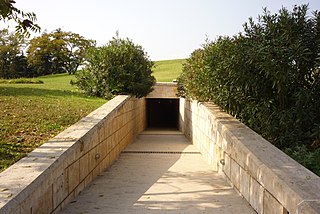
The Museum of the Royal Tombs of Aigai (Vergina) is located 75 km west of Thessaloniki, Greece, centered around the royal tombs built by the ancient Kingdom of Macedon at Aigai. The underground museum containing the burial cluster of Philip II of Macedon began construction in 1993 and was inaugurated in 1997. Exhibits are presented in four connected areas, including the Palace, the royal burial cluster of the Temenid dynasty (burial cluster "C"), the burial cluster of Philip II, and a gateway entrance with a semi-open-air exhibition of the sculptures found in the city sanctuaries and the restored upper floor of the Palace of Philip's facade. The tombs and other archaeological sites of Aigai were inscribed on the UNESCO World Heritage List in 1996 because of its exceptional architecture and testimony to the transition between city-states and empires in European civilization.

























